
FYZIKA
PHYSICS FOR KIDS - file to download
Speed and Velocity
https://www.ducksters.com/science/physics/speed_and_velocity.php
—————
Liquid Pressure

Liquid Pressure is explained here.
https://www.ducksters.com/science/physics/pressure.php
—————
Archimedes Principle

You can find teh explanation of Archimedes Princile in the following webs.
https://hyperphysics.phy-astr.gsu.edu/hbase/pbuoy.html
https://www.brightstorm.com/science/physics/solids-liquids-and-gases/archimedes-principle/
—————
PHYSICS FOR KIDS - file to download
PHYSICS FOR KIDS.docx (81193)
The original source
https://www.physics4kids.com/files/motion_vectors.html
https://www.physics4kids.com/files/motion_gravity.html
Newton's Laws of MotionThere was this fellow in England named Sir Isaac Newton. A little bit stuffy, bad hair, but quite an intelligent guy. He worked on developingcalculus and physics at the same time. During his work, he came up with the three basic ideas that are applied to the physics of most motion (NOTmodern physics). The ideas have been tested and verified so many times over the years, that scientists now call them Newton's Three Laws of Motion.First Law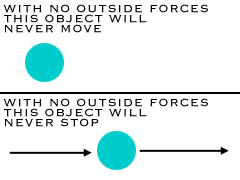 The first law says that an object at resttends to stay at rest, and an object inmotion tends to stay in motion, with the same direction and speed. Motion (or lack of motion) cannot change without an unbalanced force acting. If nothing is happening to you, and nothing does happen, you will never go anywhere. If you're going in a specific direction, unless something happens to you, you will always go in that direction. Forever. The first law says that an object at resttends to stay at rest, and an object inmotion tends to stay in motion, with the same direction and speed. Motion (or lack of motion) cannot change without an unbalanced force acting. If nothing is happening to you, and nothing does happen, you will never go anywhere. If you're going in a specific direction, unless something happens to you, you will always go in that direction. Forever. You can see good examples of this idea when you see video footage ofastronauts. Have you ever noticed that their tools float? They can just place them in space and they stay in one place. There is no interfering force to cause this situation to change. The same is true when they throw objects for the camera. Those objects move in a straight line. If they threw something when doing a spacewalk, that object would continue moving in the same direction and with the same speed unless interfered with; for example, if a planet's gravity pulled on it (Note: This is a really really simple way of descibing a big idea. You will learn all the real details - and math - when you start taking more advanced classes in physics.). Second Law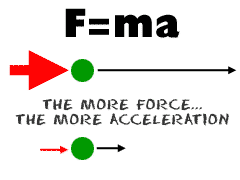 The second law says that theacceleration of an object produced by a net (total) applied force is directly related to the magnitude of the force, the same direction as the force, and inversely related to the mass of the object (inverse is a value that is one over another number... the inverse of 2 is 1/2). The second law shows that if you exert the same force on two objects of different mass, you will get different accelerations (changes in motion). The effect (acceleration) on the smaller mass will be greater (more noticeable). The effect of a 10 newton force on a baseball would be much greater than that same force acting on a truck. The difference in effect (acceleration) is entirely due to the difference in their masses. The second law says that theacceleration of an object produced by a net (total) applied force is directly related to the magnitude of the force, the same direction as the force, and inversely related to the mass of the object (inverse is a value that is one over another number... the inverse of 2 is 1/2). The second law shows that if you exert the same force on two objects of different mass, you will get different accelerations (changes in motion). The effect (acceleration) on the smaller mass will be greater (more noticeable). The effect of a 10 newton force on a baseball would be much greater than that same force acting on a truck. The difference in effect (acceleration) is entirely due to the difference in their masses. Third LawThe third law says that for every action (force) there is an equal and opposite reaction (force). Forces are found in pairs. Think about the time you sit in a chair. Your body exerts a force downward and that chair needs to exert an equal force upward or the chair will collapse. It's an issue of symmetry. Acting forces encounter other forces in the opposite direction. There's also the example of shooting a cannonball. When the cannonball is fired through the air (by the explosion), the cannon is pushed backward. The force pushing the ball out was equal to the force pushing the cannon back, but the effect on the cannon is less noticeable because it has a much larger mass. That example is similar to the kick when a gun fires a bullet forward. |
Forces of Attraction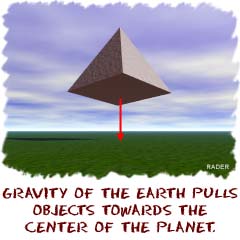 Gravity or gravitational forces are forces of attraction. We're not talking about finding someone really cute and adorable. It's like the Earth pulling on you and keeping you on the ground. That pull is gravity at work. Gravity or gravitational forces are forces of attraction. We're not talking about finding someone really cute and adorable. It's like the Earth pulling on you and keeping you on the ground. That pull is gravity at work. Every object in the universe that hasmass exerts a gravitational pull, orforce, on every other mass. The size of the pull depends on the masses of the objects. You exert a gravitational force on the people around you, but that force isn't very strong, since people aren't very massive. When you look at really large masses, like the Earth and Moon, the gravitational pull becomes very impressive. The gravitational force between the Earth and the molecules of gas in the atmosphere is strong enough to hold the atmosphere close to our surface. Smaller planets, that have less mass, may not be able to hold an atmosphere. Planetary GravityObviously, gravity is very important on Earth. The Sun's gravitational pull keeps our planet orbiting the Sun. The motion of the Moon is affected by the gravity of the Sun AND the Earth. The Moon's gravity pulls on the Earth and makes the tides rise and fall every day. As the Moon passes over the ocean, there is a swell in the sea level. As the Earth rotates, the Moon passes over new parts of the Earth, causing the swell to move also. The tides are independent of the phase of the moon. The moon has the same amount of pull whether there is a full or new moon. It would still be in the same basic place.We have to bring up an important idea now. The Earth always produces the same acceleration on every object. If you drop an acorn or a piano, they will gain velocity at the same rate. Although the gravitational force the Earth exerts on the objects is different, their masses are just as different, so the effect we observe (acceleration) is the same for each. The Earth's gravitational force accelerates objects when they fall. It constantly pulls, and the objects constantly speed up. They Always ask About Feathers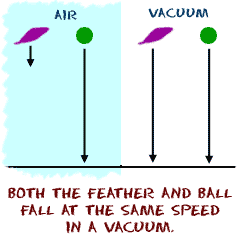 People always say, "What about feathers? They fall so slowly." Obviously, there is air all around us. When a feather falls, it falls slowly because the air is in its way. There is a lot of air resistance and that resistance makes the feather move slower. The forces at work are the same. If you dropped a feather in a container with no air (a vacuum), it would drop as fast as a baseball. People always say, "What about feathers? They fall so slowly." Obviously, there is air all around us. When a feather falls, it falls slowly because the air is in its way. There is a lot of air resistance and that resistance makes the feather move slower. The forces at work are the same. If you dropped a feather in a container with no air (a vacuum), it would drop as fast as a baseball. What About the Moon?But what keeps the Moon from falling down, if all of this gravity is so strong? Well, the answer is that the moon IS falling; all the time, but doesn't get any closer to us! Remember that if there wasn't a force acting, the Moon would be traveling in a straight line. Because there IS a force of attraction toward the Earth, the moon "falls" from a straight line into a curve (orbit) around the Earth and ends up revolvingaround us. The Earth's gravity holds it in orbit, so it can't just go off in a straight line. Think about holding a ball on a string and spinning it in a circle. If you were to cut that string (no more gravity), the ball would fly off in a straight line in the direction it was going when you cut the string. That direction, by the way, is not directly away from your hand, but tangent to the circle. Tangent is a geometry term used to describe a direction that are related to the slope of a curve. Math stuff. The pull of the string inward (toward your hand) is like the Earth's gravitational pull (inward toward the center of the Earth).------------------------------------------------------------------------ Vector Basics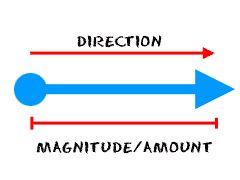 Force is one of many things that are vectors. What the heck is a vector? Can you hold it? No. Can you watch it? No. Does it do anything? Well, not really. Avector is a numerical value in a specificdirection, and is used in both math and physics. The force vector describes a specific amount of force and its direction. You need both value and direction to have a vector. Both. Very important. Scientists refer to the two values as direction and magnitude (size). The alternative to a vector is a scalar. Scalars have values, but no direction is needed. Temperature, mass, and energy are examples of scalars. Force is one of many things that are vectors. What the heck is a vector? Can you hold it? No. Can you watch it? No. Does it do anything? Well, not really. Avector is a numerical value in a specificdirection, and is used in both math and physics. The force vector describes a specific amount of force and its direction. You need both value and direction to have a vector. Both. Very important. Scientists refer to the two values as direction and magnitude (size). The alternative to a vector is a scalar. Scalars have values, but no direction is needed. Temperature, mass, and energy are examples of scalars. When you see vectors drawn in physics, they are drawn as arrows. The direction of the arrow is the direction of the vector, and the length of the arrow depends on the magnitude (size) of the vector. Real World Vectors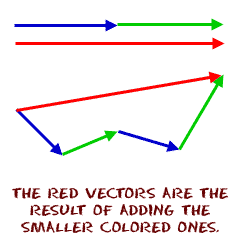 Imagine a situation where you're in a boat or a plane, and you need to plot a course. There aren't streets or signs along the way. You will need to plan your navigation on a map. You know where you're starting and where you want to be. The problem is how to get there. Now it's time to use a couple of vectors. Draw the vector between the two points and start on your way. As you move along your course, you will probably swerve a bit off course because of wind or water currents. Just go back to the map, find your current location, and plot a new vector that will take you to your destination. Captains use vectors (they know the speed and direction) to plot their courses. Imagine a situation where you're in a boat or a plane, and you need to plot a course. There aren't streets or signs along the way. You will need to plan your navigation on a map. You know where you're starting and where you want to be. The problem is how to get there. Now it's time to use a couple of vectors. Draw the vector between the two points and start on your way. As you move along your course, you will probably swerve a bit off course because of wind or water currents. Just go back to the map, find your current location, and plot a new vector that will take you to your destination. Captains use vectors (they know the speed and direction) to plot their courses. Combining VectorsWe're hoping you know how to add and subtract. Scientists often use vectors to represent situations graphically. When they have many vectors working at once, they draw all the vectors on a piece of paper and put them end to end. When all of the vectors are on paper, they can take the starting and ending points to figure out the answer. The final line they draw (from the start point to the end point) is called the Resultant vector. If you don't like to draw lines, you could always use geometry and trigonometry to solve the problems. It's up to you. Unlike normal adding of numbers, adding vectors can give you different results, depending on the direction of the vectors. |